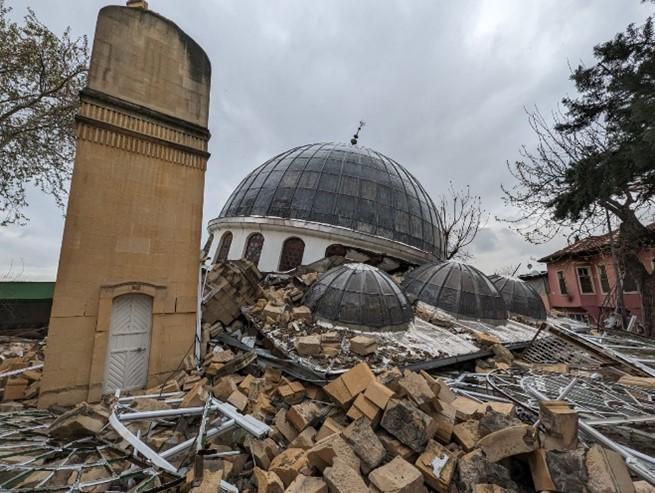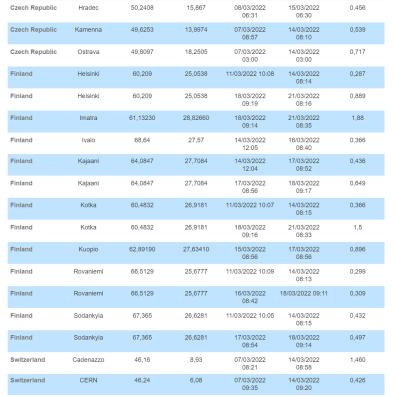IRSN co-led the French in situ post-earthquake survey in Türkiye under the umbrella of the French Association for Earthquake Engineering (AFPS)

Following the earthquakes occurred on the 6th of February 2023 (Mw of 7.8 and 7.5) in the regions of Hatay and Kahramanmaraş in southern part of Türkiye, the French Association for Earthquake Engineering decided to send an in situ post-earthquake survey from the 31 March 2023 to the 9 April 2023 to gather information to identify the lessons applicable to the French context. The post-earthquake survey was composed of 11 members, co-headed by Benjamin Richard (IRSN) and Pierre Alain Nazé (GDS).
Various topics were addressed within the survey: seismology, geotechnics, seismic behavior of conventional buildings and industrial sites (e.g. dams), architecture and cultural heritage, seismic regulation, crisis management and structural assessment in post-earthquake situation.
A public technical feedback will be organized at the Ecology Ministry at La Défense in September 2023 and a public report will be produced.
For more information
- http://www.afps-seisme.org/ACTIVITES/Missions-post-sismiques/2023-Turqu…
- To learn more about seismology, earthquake engineering, assessment methods :️ https://www.ensta-paris.fr/index.php/fr/lancement-du-1er-mooc-sur-les-s…
Ukraine: Report on fires in the Chernobyl exclusion zone
Current situation
In a press release on 21 March 2022, the Ukrainian safety authority SNRIU indicated that forest fires had been burning in the Chernobyl exclusion zone since 11 March, mainly in the central and west areas of the exclusion zone created after the accident in 1986. The IAEA was also informed by SNRIU (cf. Update 30 – IAEA Director General Statement on Situation in Ukraine).
Experience feedback
Large-scale fires occur every year in Russia, Belarus and Ukraine. Some of these fires affect the areas contaminated by the Chernobyl accident. During such events, air masses can absorb radioactivity and move towards Western Europe and France, as was the case in 2002, 2010 and 2020, for example.
Since the Chernobyl accident, tree trunks/branches and litter (layer of leaves which fall year after year) in the contaminated areas of Belarus, Ukraine and Russia tend to store the radionuclides initially deposited on the ground and absorbed by roots. If such matter is burned, these radionuclides can be partially released in the smoke and hence contaminate the air. This is particularly true for caesium 137, the main radionuclide dispersed in Europe during the Chernobyl accident and still detectable today.
It is important to take note that these events have led, to date, to very low-level ambient activity, which cannot be measured in France other than using the air sampling stations of the IRSN OPERA-Air network. Measurements are taken for the filters in this network using high-performance laboratory techniques and detect very small amounts of radioactivity. During the episode in April 2020, only nine measurements taken at these samplers in France could be considered as in excess of usual background levels (approx. 0.1 µBq/m3 in France), with very low levels nonetheless, of between 0.51 ± 0.20 µBq/m3 of air (Fessenheim) and 1.31 ± 0.24 µBq/m3 of air (Cadarache). Other European countries and Ukraine also detected the impact of fires during this event. In the Chernobyl exclusion zone, activity levels occasionally reached several mBq/m3 of caesium 137.
Available data on 24 March 2022
Equivalent Dose Rate (EDR) monitoring stations in the exclusion zone, managed by Ecocentre, a Ukrainian government-operated firm, and stations near to the Chernobyl reactors (including reactor n°4 damaged in 1986) managed by the site operator, ceased operation in late February 2022 due to the current conflict. On this basis, these stations are no longer providing data on radioactivity in the zone.
The Ukrainian national network station, located in the town of Chernobyl, is still transmitting data, but intermittently, due to power supply problems in the area. Up to 18 March, the last date on which this station transmitted the mean hourly EDR over a 24-hour period, radioactivity was not abnormally high.
The following map shows the stations of the Belarus and Ukrainian national networks, which transmit data to the European EURDEP system (mean EDR over 24h), in a 200 km radius around the Pripyat site. None of these stations have indicated a significant increase in EDR over the 11 - 18 March period, and local fluctuations were systematically less than 50 nSv/h.

SNRIU also informed the IAEA that very slight increases in airborne caesium-137 levels had been detected in Kiev and by radiological monitoring at the Rovno NPP and Khmelnitsky NPP in the west of the country, but that these detections did not pose a radiological problem.
In addition, aerosol filter measurements from other European countries currently available in the EURDEP system do not indicate any significant increase in caesium 137 ambient activity levels (see table below). Filters of IRSN's national OPERA-Air network for the period in question are analyzed as they are received.
Results of aerosol filter measurements in European countries: Caesium-137 activity levels in air

Ukraine: Situation at the Chernobyl site
On 9 March at 11.22am, the Ukrainian nuclear safety authority SNRIU informed IAEA that the external power supplies of the Chernobyl plant facilities had been cut off. The site's emergency generators would be supplying power to the facilities, with enough fuel for 48 hours.
IRSN presents below an assessment of the risks associated with the loss of external power supplies for the site’s various facilities, including the loss of emergency power supply, which is a potential situation that could come about rapidly if power is not restored to the site because the generator fuel reserves run out.
Reactors
Reactors 1, 2 and 3 at the Chernobyl site have been shut down for over 20 years. All the fuel assemblies of these reactors have been transferred to the site's storage facility (see below). There is no risk of releases from these facilities, which are not backed up by diesel generators.
Reactor 4, which was damaged in 1986, was initially covered by a temporary sarcophagus as an emergency measure. Uncertainties concerning the structural resistance of this sarcophagus led to the construction of a containment structure (NSC for New Safe Confinement), which was completed in 2017 (250 m wide, 160 m long, 100 m high). The temporary sarcophagus is being dismantled. The NSC ventilation system is backed up by two dedicated generators. In the event of total loss of electrical power, facility containment will be provided solely by the static containment of the structure. The dismantling of the sarcophagus of the damaged reactor has probably been suspended due to the conflict, so this containment should be sufficient to prevent releases into the environment.
Spent fuel storage facility
The facility consists of a storage pool (ISF-1) with approximately 20,000 assemblies and a dry storage facility (ISF2). Spent fuel elements are gradually transferred from the pool to ISF-2.
- Underwater storage pool ISF 1
The safety systems of this facility are backed up by two diesel generators with fuel reserves to last 48 hours.
The studies carried out after the accident at the Fukushima Daiichi plant on the consequences of total loss of the pool cooling systems indicate a slow rise in pool water temperature to a temperature of around 60°C but no dewatering of the assemblies and therefore no radioactive releases into the environment.
- ISF 2 dry storage facility
To date, about 2,000 assemblies have been transferred from ISF-1 to ISF-2.
This facility does not present a risk in the event of total loss of electrical power, as the power removal from thefuel assemblies is completely passive.
Loss of the facility’s control systems
Although the loss of power at the Chernobyl site does not have consequences that could lead to environmental releases, it does imply the loss of the facility's command-control systems. Thus, all the technical data used by the site’s real-time monitoring (water level, temperature, radioactivity, etc.) and alarm systems will cease to be available; this could delay the reactions of personnel if an incident occurs on the facility.
The loss of power would also mean the loss of lighting, heating and certain communication systems, resulting in deteriorated working conditions for personnel, who are already suffering from the stress of the current situation.
Download IRSN information note from March 10, 2022 (PDF)
Chernobyl, 35 years later

35 years after the Chernobyl nuclear accident, which occurred on 26th April 1986 in Ukraine, IRSN outlines the latest information on the situation at the site and the consequences of the accident.
Download our information reports:
